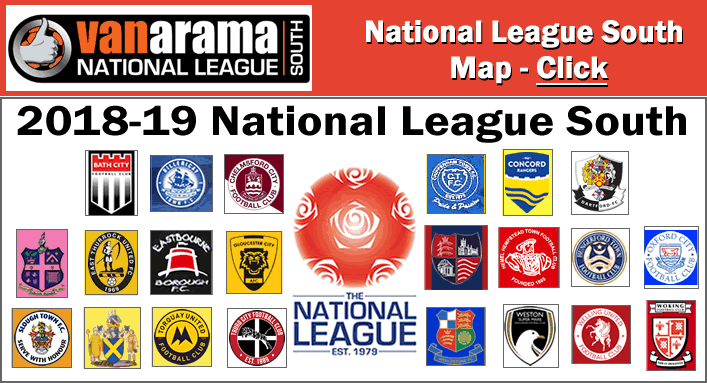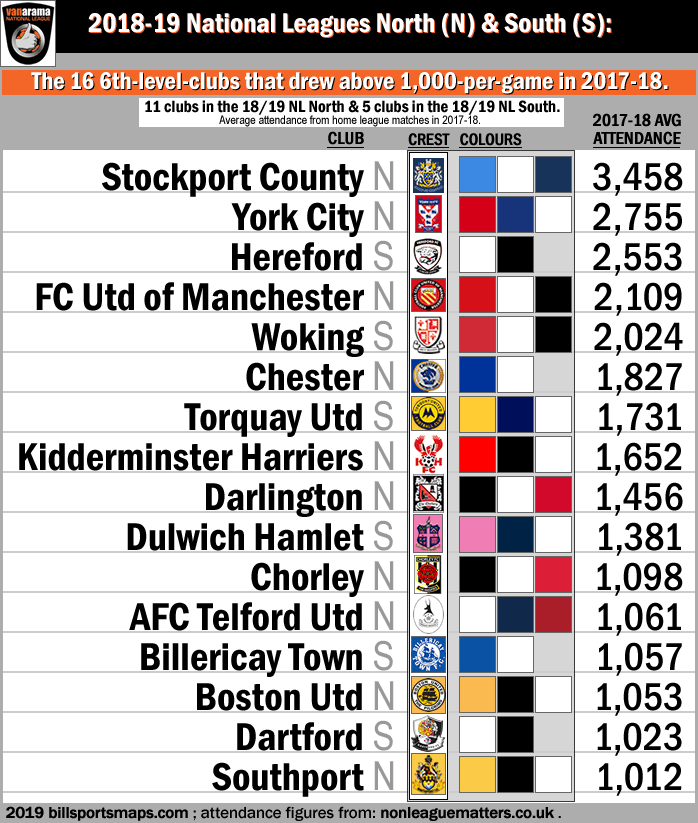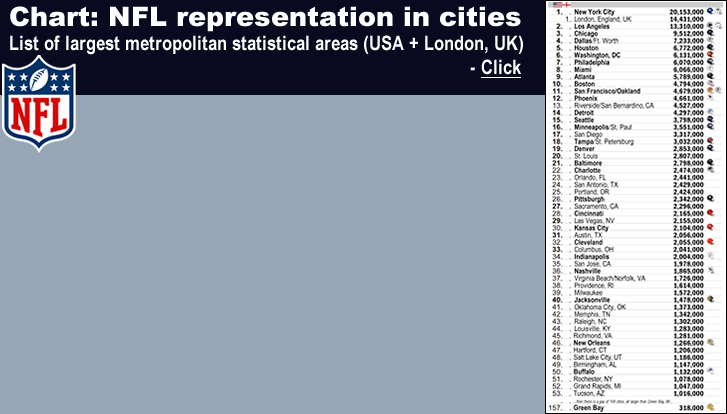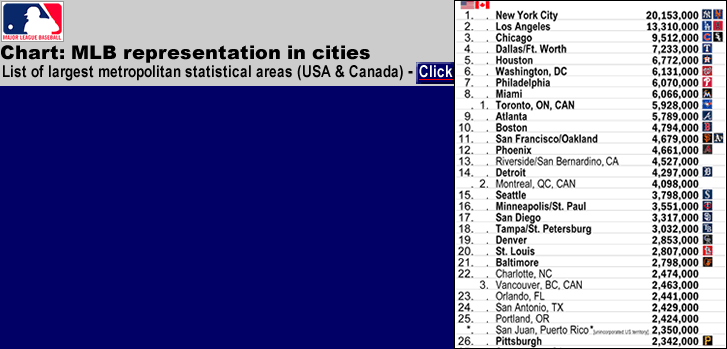Main map – 2018-19 National Leagues North and South (44 teams/2 leagues) – click on image below

Main map – 2018-19 National Leagues North and South (44 teams/2 leagues)
…
…
By Bill Turianski on 25 June 2018; twitter.com/billsportsmaps.
Links…
-National League (English football) (en.wikipedia.org).
-Official site…thenationalleague.org.uk
-Nuneaton Town changes name back to Nuneaton Borough…ANNOUNCEMENT: Back to the Borough (pitchero.com/clubs/nuneatontownfc).
-Bradford Park Avenue changes name back to Bradford (Park Avenue) AFC…Club To Revert Back To Historic Name And Badge (bpafc.com).
-FA chiefs restructure non-league game [below the 6th level] (bbc.com/sport/football).
-Non-League allocations for 2018-19 Steps 1-4 (ie, levels 5-9) [pdf] (thefa.com).
…
- 6th division England:
2018-19 National League North & National League South (2 separate 22-team leagues, at the same level)
The 6th level in English football is where the regionalised leagues begin. Above is the 5th division, the National League, which is the highest level of non-League football and the only non-League level that is nationalised. The 6th level has two leagues: the National League North and the National League South. Below that is the 7th level, which used to be comprised of 3 leagues, but starting now [2018-19] there will be 4 leagues in the 7th level (the new league in the 7th level will be the result of splitting the Southern League into two leagues: the Southern League – Central and the Southern League – South) {see link to article at BBC/sports above; also see pdf above, which shows the whole set-up in chart form}.
A brief history of the 5th and 6th tiers in England…
1979-80: 5th level of English football instituted with the Alliance Premier League: the 5th level and the highest level of non-League football in England (and Wales).
1986-87: Promotion/Relegation established between the 5th level and the 4th Division of the Football League.
2004-05: The 6th level of football instituted, with the creation of 2 regional leagues below the 5th level: the Conference North & the Conference South (22 teams in each league).
2015-16: names of the three leagues changed to…5th level: National League / 6th level: National League North & National League South.
…
The map(s)…
Above is the two leagues combined on one map (click on image at the top of the post for all 44 teams in the 2018-19 National Leagues North & South)…
Below is a map each for: the 2018-19 National League North, and the 2018-19 National League South. All the maps are location-maps which also show each club’s 2017-18 home average attendance as well as their 2017-18 league finish (with play-off bids and promotion/relegation noted).
There is also a small chart further below, which shows the 16 clubs in the 2018-19 6th level that drew above 1,000-per-game last season [in 2017-18] (11 clubs in the 18/19 NL North / 5 clubs in the 18/19 NL South). Then I wrote a few words about each of the sixteen 6th-tier clubs that drew above 1,000 per game last season.
My next post will be a map of the 2018-19 National League [the 5th division], with illustrated profiles of the 4 promoted clubs (Salford City, Harrogate Town, Havant & Waterlooville, Braintree Town). That will be posted on the 11th of July 2018.
…
Map of National League North (2018-19 season, with attendances and finishes from 2017-18) – click on image below

National League North 18/19 map w/ 17/18 attendances and finishes
…
Map of National League South (2018-19 season, with attendances and finishes from 2017-18) – click on image below

National League South 18/19 map w/ 17/18 attendances and finishes
…
6th Level clubs which draw above 1,000-per-game (16 clubs: 11 in the National League North / 5 in the National League South)…

Attendance figures from: nonleaguematters.co.uk.
Top draws in the 6th tier…
Stockport County: 99 seasons in the Football League (last in 2010-11). Financial problems have plagued the club since the early 2000s, and that led it to being a supporter-owned club for a while circa 2005-10. Stockport were in the 2nd division as recently as 2001-02. They were drawing between 6-to-8-K back then. But though they have fallen a ways since then (4 relegations), Stockport County can still draw above 3 K despite being stuck in the 6th tier (and in 17/18 they drew 3.4 K for the second-straight season). Stockport will be playing their 6th season of 6th-division football in 2018-19. Stockport, population 136,000 {2011 census}, was historically part of Cheshire, but now is in Greater Manchester. As the crow flies, Stockport is about 7 miles south of central Manchester. Stockport County wear Blue-and-White, but last season they wore pale-royal-blue-with-navy-blue-and-white-trim. Stockport County play at Edgeley Park, which has a 10.8-K-capacity (all seated).
York City: 72 seasons in the Football League (last in 2015-16). Back-to-back relegations have devastated the North-Yorkshire-based club. But most of their supporters have not abandoned them…York were drawing 3.2 K in their last Football League season (2015-16), and have only dropped off about .5 K (down 14%) since then. York drew 2.7 K last season, as they were relegated to the 6th tier for the first time. York City wear unique Red jerseys with Dark-Blue sleeves, and play at Boothan Crescent (cap. 8, 256).
Hereford: Phoenix-club of Hereford United (1924-2014). They still play at Edgar Street (though one stand behind the goal failed the safety inspection). The 4-year-old re-formed club has been marching up the pyramid, with 3 straight league-winning promotions. And their support has been outstanding. In their inaugural season, Hereford drew an astounding 2.8 K in the 9th-level Midlands League (in 2015-16). Then in 16/17, the Bulls drew 2.8 K again (in the 8th tier, winning the South League South & West by 18 points). Their support tailed off a little last season (maybe because they clinched the league title again with such ease). Hereford drew 2.5 K and won the Southern League by 13 points. And Hereford drew about 1.7-K-per-game more than anyone else in the Southern League last season. Hereford make their 6th-level debut, now situated in the National League North. Hereford will probably will be one of the favorites for promotion (again). Like the original club, Hereford wear White-with-Black.
FC United of Manchester: Supporter-owned club. Protest-club formed in 2005, after the cynical debt-laden leveraged-buyout of Manchester United by the Glazers. FC United started off with three consecutive promotions (2006-08). The club won promotion to the 6th tier in April 2015, and a month later, in May 2015, FC United moved into their nice and functional purpose-built Broadhurst Park (cap. 4,400). But factional unrest within the club has hurt them in the past couple of years. Attendance has fallen 1.2 K in two seasons (down from 3.3 K in 15/16, to 2.1 K in 17/18). And their promotion campaign has stalled (this will be FCUM’s 4th season in the 6th tier). Like Man Utd, FC United wear Red-and-White-with-Black.
Woking: The Surrey-based club is nicknamed the Cards (as in the Cardinal red in their Red-and-White halved jerseys). Woking have never been higher than the 5th division, and were a mainstay there fifteen years ago (Woking played 17 straight seasons in the 5th tier from 1992-93 to 2008-09). But this is now their second spell in the 6th tier after 3 seasons up in the 5th. Woking draw solid (2.2 K last season), and will probably still draw above 1 K back in the 6th tier (they drew between 1.1 and 1.8 K in their 3 season-spell in the 6th tier from 2010-12).
Chester: Phoenix-club of Chester City (1985-2010). Located in western Cheshire right on the border of Wales. Like the club they replaced, Chester play at the Deva Stadium (cap. 5,400 with 4 K seated). (The Deva Stadium is actually partially located in Wales.) Like FC United of Manchester, and also like Hereford, Chester began life (in 2010-11) with three straight promotion-winning seasons. That got them to the 5th tier, but then Chester stalled out after 4 seasons in the 5th division, and now find themselves back in the 6th tier. Crowds have diminished, somewhat alarmingly (down almost .9 K in 6 years, from 2.7 K in the promotion-winning season of 2011-12, to 1.8 K last season). Chester wear Blue-and-White.
Torquay United: 78 seasons in the Football League (last in 2013-14). Torquay are located on the south-west coast, in Devon. Torquay have now suffered two relegations in 5 seasons. The first time they were stuck in non-League, they escaped back to the Football League after just 2 seasons. That was in 2008-09. Then followed 5 seasons in the 4th division, and Torquay were good enough to make the play-offs twice in that 5-year stint, even making it to the League Two play-off final in 2011 (losing to Stevenage). But now the Gulls are moving out of the 5th division in the wrong direction. In 6 seasons, Torquay have lost 40% of their fanbase, going from 2.8 K in League Two in their 2011-12 play-off run, to 1.7 K last season when they were relegated. Torquay wear Yellow-and-Navy-Blue.
Kidderminster Harriers: 5 seasons in the Football League (last in 2004-05). Kidderminster is a town of 55,000 located just south of the West Midlands, in north Worcestershire, 17 miles (27 km) south-west of Birmingham city centre. Robert Plant (of Led Zeppelin fame) grew up here. In 2000-01, Kidderminster drew an all-time high of 3.4 K. That was the season of their Football League debut. The dream lasted 5 seasons. Back in non-League 5 years later, Kidderminster were drawing above-or-near 2 K most seasons. Kidderminster drew 1.6 K last season and are now entering their 3rd season in the 6th tier. Kiddy wear Red-with-Black-and-White.
Darlington: 81 seasons in the Football League (last in 2009-10). Saddled by the White Elephant that was the 25-K-capacity Darlington Stadium, Darlington were a financial mess by the time they were relegated out of the 4th division in April 2010. Darlington were drawing 1.9 K and playing in a 25.5-K-arena. Of course it was going to end badly. Two years later, in 2012, Darlington were expelled from the Conference National [the 5th division]. The Phoenix-club Darlington 1883 rose in its place…‘A new club was immediately formed but The Football Association ruled that, as a new club, it must have a different playing name from the expelled club. The name chosen was Darlington 1883, and that club was placed in the Northern League Division One, the ninth tier of English football, for the 2012–13 season. They won three promotions in four seasons before the FA approved their request to change to the traditional Darlington FC name.’ {-excerpt from en.wikipedia.org/wiki/Darlington_F.C..} Darlington are from County Durham. The town of Darlington has a population of around 92,000 and is located 37 miles by road S of Newcastle, and about 4 miles north of the border with North Yorkshire. Darlington wear sharp-looking Black-and-White hoops, and are nicknamed the Quakers. They drew 1.2 K when they won the Northern League (7th tier) in 2015-16. Darlington were a mid-table side that drew 1.4 K last season, but that was a let-down from their strong run 2 years ago (2016-17), when they drew 1.7 K and finished in 5th (but Darlington 1883 were barred from the play-offs due to failing ground size regulations). Still, it looks like Darlington are going in the right direction. Especially because they have been playing back in town since 2016-17, at the 3,000-capacity Blackwell Meadow, which they rent from rugby league side Darlington RFC.
Dulwich Hamlet: Despite being rendered homeless by soulless corporate landlords, Dulwich Hamlet won promotion into the 6th tier, by winning the Isthmian play-off final (beating Hendon 1-1/4-3 on penalties). The Pink-and-Navy-Blue-clad Dulwich Hamlet are from South London, in the London Borough of Southwark. (Dulwich Hamlet attract a fanbase that has been derided as hipster. Oh, so a lot of them have beards and like artisanal products, whatever, more power to them; they’re from the largest city in the UK and yet they are still supporting lower non-League football, and that is good enough for me.) For three years the club has been drawing impressively for a 7th-tier side. They drew 1.0 K in 2015-16, and then in ’16-17 and ’17-18, Dulwich Hamlet drew 1.3 K (in a division where the median average attendance is only about 250). But last season, as the squad chased promotion, their eviction from their Champion Field ground diminished their crowd-size considerably. In March and April 2018, once they were forced to play at Tooting & Micham’s Imperial Field (located 5 miles away, further south-west, in SW London), Dulwich Hamlet started seeing smaller crowds: like 800 or so, instead of the 1,300 or so they were drawing earlier that season. And so it is going to be interesting to see, in 2018-19, how Dulwich Hamlet do, as a new 6th-division-side that also happens to be homeless.
AFC Telford United: Phoenix-club of Telford United (1872-2004). Telford United were a founding member of the 5th division (Alliance Premier League) in 1979. AFC Telford Utd play at the 6,300-capacity New Bucks Head (opened 2003), which was originally built for Telford United to play at before they went bankrupt. Telford United was a mainstay of the 5th tier back in the 1990s, but never played above the 5th division. The re-formed club has had a harder time surviving in the 5th tier. Although AFC Telford United have been drawing above 1 K, most seasons, for many years now, they have become more of a 5th-division/6th-division yo-yo club, with their most recent relegation in 2014-15. Nicknamed the Lilywhites or the Bucks, Telford wear White with navy and red trim, and now they wear Navy Blue pants (previously black). Telford, located in Shropshire, is somewhat of a commuter-town of Birminghmam. Telford is on the large side for a non-League town: its population is around 142,000 {2011 census figure}.
Billericay Town: Controversial owner Glenn Tamplin is widely disliked, with appalling behavior towards one of his players and towards rival fans on social media. Tamplin also fired the manager, took the manager’s job for himself, then fired himself, then when he couldn’t find another manager, he re-instated himself. But despite all this, the club has just been promoted to the 6th tier for the first time. Billericay Town got there with a huge wage bill that included former-Premier-League talent. Attendance has shot up almost 500, from 565 per game two years ago, to 1,057 last season, when Billericay won the Isthmian League by 4 points over Dulwich Hamlet. Billericay, Essex, with a population of around 28,000, is a commuter town that is located, by road, 34 miles (55 km) E of central London. Billericay Town wear all-Blue (dark Cornflower blue).
Boston United: 5 seasons in the Football League (last in 2006-07). Boston got into the Football League on tainted circumstances in 2002 (violation of registration rules), and after 5 seasons in the 4th division, they were relegated back to non-League. And at that point, the club was in such poor financial shape that they were demoted further down an extra level, down to the 6th tier. And Boston United has basically never recovered from that. Boston is in Lincolnshire; the town of Boston has a population of around 35,000. Boston United are nicknamed the Pilgrims, and wear Amber-and Black.
Dartford: Dartford are from Dartford, Kent. The town of Dartford is home to the Dartford Crossing, the easternmost transit over the River Thames. Dartford FC play at the marvelous Princes Park, a singular ground that is environmentally-friendly and is built primarily of wood and has a living green-roof over the clubhouse. Princes Park opened in November 2006, and has a capacity of 4,100 (642 seated). The new and unique ground greatly improved the club’s crowd-size (crowds went from the mid-200s to over 800), and helped propel them to promotion to the 7th division in 2008, and then into the 6th division in 2010, and then into the 5th division in 2012. In their promotion-winning season of 2011-12, Dartford drew 1.2 K. And in their first season in the 5th tier they drew an all-time high of 1.3 K. Dartford had a three-season-spell in the 5th tier (2012-15). Back in the 6th tier, Dartford are still drawing above 1 K, but only slightly (in 2017-18, Dartford drew 1,023). In 2017-18, Dartford just missed out on promotion, winning their last 9 games chasing Havant & Waterlooville, only to be denied automatic promotion by goal-difference. Then in the 2018 National League South play-offs, Dartford lost to the eventually-promoted Braintree Town. Dartford will probably be one of the favorites to win promotion in 2018-19. Dartford wear White-with-Black.
Southport: 50 seasons in the Football League (last in 1977-78). Southport was the last club to leave the Football League through the re-election process [automatic relegation from the Fourth Division was instituted in 1986–87]. Since then, Southport have played 19 seasons in the 5th tier, within three different spells; their last season in the 5th tier was in 2016-17. Southport have been drawing above 1 K most seasons since 1992-93. The town of Southport is part of Merseyside, and is a coastal bedroom community just north of Liverpool. Southport play at York Street, which opened in 1923 and has a capacity of 6,643 (1,826 seated). Southport are nicknamed the Sandgrounders, for the town’s sandy beach promenade, and they wear Yellow-with-Black.
___
Thanks to all at the links below…
-Thanks to the contributors at National League (English football) (en.wikipedia.org).
-Thanks to Nilfanion at Wikipedia…Blank map of UK historic counties, by Nilfanion (using UK Ordnance Survey data), at File:United Kingdom police areas map.svg (commons.wikimedia.org). Blank relief map of Greater London, by Nilfanion (using UK Ordnance Survey data), at File:Greater London UK relief location map.jpg. Blank relief map of Greater Manchester, by Nilfanion (using Ordnance Survey data), at File:Greater Manchester UK relief location map.jpg (commons.wikimedia.org).
Photos/Images of kit badges…
[Ashton Utd 17/18 jersey badge], ashtonunitedfc.gr8sports.co.uk
[Curzon Ashton 17/18 jersey badge], twitter.com/[@curzonashton].
[Chester 17/18 jersey badge], chesterfc.com/all-ticket.
[Nuneaton 18/19 kit (image of lighter-blue-fade-striping behind the badge)], twitter.com/[@Official_NTFC]
[Spennymoor 14/15 jersey badge], oldfootballshirts.com.
[Billericay], billericaytownfc.co.uk/product/2017-18-home-shirt-2.
[Chippenham], pitchero.com/clubs/chippenhamtown.
[Dulwich Hamlet], pitchero.com/clubs/dulwichhamlet/.
[Eastbourne (script on badge)], ebfc.co.uk/news.
-Thanks to the Non-League Matters site for non-League attendance figures, nonleaguematters.co.uk.


